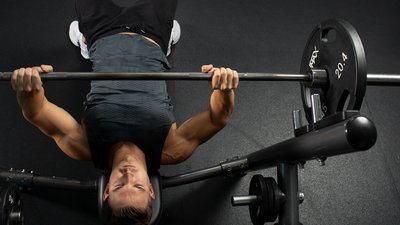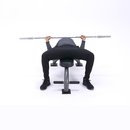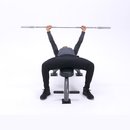The chest is such a noticeable muscle group and having an impressive chest is an important part of a balanced physique. The anatomy of the chest is made up of two main muscles. The Pectoralis major is that big muscle that covers each half of the front of your chest. One of its jobs is to turn your arm inward. Its other job is to help pull your arm forward and down. Pectoralis minor is directly under pectoralis major. It's attached to your third, fourth and fifth ribs at the bottom, and at the top it's attached to the front of your shoulder blade. It helps pull your shoulder blade down, and it helps hold your shoulder down when you have to push down with your hands.
Theory Of Heavy Pressing Movements
Chest is a muscle that is hit best by heavy pressing movements. as the chest looks best with mass and the best way to get mass is by using heavy pressing movements. People often think that the pectorals are a large muscle group but compared to the rest in the body they are really only a medium-sized muscle group. Therefore too many sets are not needed.
I always aim for 9 sets after I warm up. Others may like more or less but for me it seems to be the perfect number. Chest is best hit from three angles. Upper—incline, middle-flat, lower—dips. but of course they are not separate muscles. Training chest should be done using free weights; sure there are other ways of training chest on machines or even the Smith Machine (avoid not proper range of motion for pressing) but the free weights are far better for adding mass as they incorporate stabilisers.
As far as reps go everyone is different, but I have found that lower reps really help me to add mass and strength so I train chest with 6 reps. Regarding what angle to set your incline bench to, anywhere between 10-30 degrees is perfect but any higher creates more emphasis on the shoulder muscles.

BodyFit
$6.99/month- 2,500+ expert-created single workouts
- 3,500+ how-to exercise videos
- Detailed workout instruction
- Step-by-step workout tips
- Training at gym or at home
- Access to Workout Plans
- Access to Bodyfit App
- Store Discounts
Already have a Bodybuilding.com account with BodyFit? Sign In

What comes with BodyFit?

- Instructional Videos
Don't risk doing a workout improperly! Avoid injury and keep your form in check with in-depth instructional videos.

- How-to Images
View our enormous library of workout photos and see exactly how each exercise should be done before you give it a shot.

- Step-by-Step Instructions
Quickly read through our step-by-step directions to ensure you're doing each workout correctly the first time, every time.
Other Useful Chest Exercises
- Flyes
- Decline press
- Cable cross-overs
- Pull-overs
How To Break Your Bench Plateau
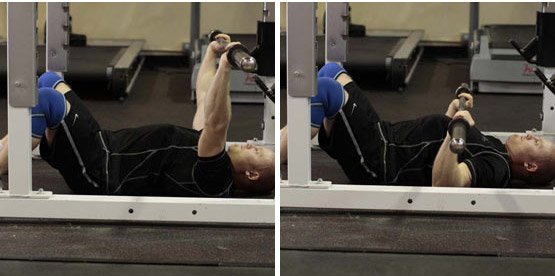
Floor Press
Pause Press: Regular flat bench, pause for 2-3 seconds at the bottom of the bench. Good for strengthening lower part of bench.
Floor Press: Bench press done on the floor in the power rack. Works triceps and top part of bench (depends on the size of chest/back and length of arms).
Dumbbell Work: Dumbbells are great for teaching you how to press and also great for building stability in the shoulder and lat muscles.
Max Effort Work: The next three movements would be used as max effort movements concentrating on building power off your chest. I'd still cycle in the other max effort movements like the board press and lockouts every other week for the top part of the bench. This will keep building on the top strength you already have.
Dynamic-effort Method: This method is best defined as training with sub-maximal weights (45 to 60%) maximal velocities. The key to this method is bar speed.
Board Press: Place pieces of wood on your chest and bench; kind of like limiting the ROM to work certain parts.
Chains: Adding chains to the ends of the barbell at the bottom of the lift the chain is almost all deloaded so very little impact. As you start pressing it back up the chain lifts off the floor and adds weight. Good for mid-point of bench.
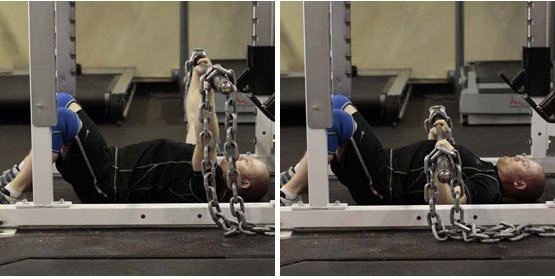
Floor Press with Chains
Pin Presses: In the power rack, set the pins too limit your ROM(6-8 in.) from lockout of your bench press. Since it is a short ROM you can use very heavy weight, more than your max, hitting your triceps hard and helping your lockout on the bench press.
Bench Press Tips
Tear the Bar Apart
Something that I've seen with myself and others is when grabbing the bar, pretend to tear it apart, then unrack it (with or without help). Once unracked, there's a tendency to forget to continue to do this tearing motion throughout the movement... trust me, it makes a difference.
Keep Your Shoulder Blades Pulled Together And Tight
This is a very important and often overlooked aspect of a great bench press. While pressing you have to create the most stable environment possible. This can't be done if your shoulder blades are off the bench. The bench is only so wide so we can change how we position ourselves on the bench.
When you pull your shoulder blades together you're creating a tighter, more stable surface from which to press. This is because more of your body is in contact with the bench. This technique also changes the distance the bar will have to travel. The key to pressing big weight is to press the shortest distance possible.
Keep The Pressure On Your Upper Back And Traps
This is another misunderstood aspect of bench pressing. You want the pressure around the supporting muscles. This is accomplished by driving your feet into the floor, thereby driving your body into the bench. Try this: lie on the bench and align yourself so that your eyes are four inches in front of the bar (towards your feet).
Now using your legs, drive yourself into the bench to put pressure on the upper back and traps. Your eyes should now be even with the bar. This is the same pressure that needs to be applied while pushing the barbell.
Push The Bar In A Straight Line
Try to push the bar towards your feet. The shortest distance between two points is a straight line, right? Then why in the world would some coaches advocate pressing in a "J" line toward the rack? If I were to bench the way most trainers are advocating (with my elbows out, bringing the bar down to the chest and pressing toward the rack) my barbell travel distance would be 16 inches.
Now, if I pull my shoulder blades together, tuck my chin and elbows, and bring the bar to my upper abdominals or lower chest, then my pressing distance is only 6.5 inches. Now which would you prefer? If you want to push up a bar-bending load of plates, you'd choose the shorter distance.
Here's another important aspect of pressing in this style. By keeping your shoulder blades together and your chin and elbows tucked, you'll have less shoulder rotation when compared to the J-line method of pressing. This is easy to see by watching how low the elbows drop in the bottom part of the press when the barbell is on the chest. With the elbows out, most everyone's elbows are far lower than the bench. This creates a tremendous amount of shoulder rotation and strain.
Now try the same thing with the elbows tucked and shoulder blades together while bringing the barbell to your upper abdominals. For most people, the elbows are usually no lower than the bench. Less shoulder rotation equals less strain on the shoulder joint.
I've always been amazed at trainers that suggest only doing the top half of the bench press, i.e. stopping when the upper arms are parallel to the floor. This is done to avoid the excess shoulder rotation. All they have to do is teach their clients the proper way to bench in the first place!
Keep The Elbows Tucked And The Bar Directly Over The Wrists And Elbows
This is probably the most important aspect of great pressing technique. The elbows must remain tucked to keep the bar in a straight line as explained above. Keeping the elbows tucked will also allow lifters to use their lats to drive the bar off the chest. Football players are taught to drive their opponents with their elbows tucked, then explode through.
This is the same for bench pressing. Bench pressing is all about generating force. You can generate far more force with your elbows in a tucked position compared to an "elbows out" position.
The most important aspect of this is to keep the barbell in a direct line with the elbow. If the barbell is behind the elbow toward the head, then the arm position becomes similar to an extension, not a press.
Bring The Bar Low On Your Chest Or Upper Abdominals
This is the only way you can maintain the "barbell to elbow" position as described above. You may have heard the advice, "Bring it low" at almost every powerlifting competition. This is the reason why. Once again, the barbell must travel in a straight line.
Fill Your Belly With Air And Hold It
For maximum attempts and sets under three reps, you must try to hold your air. Everyone must learn to breathe from their bellies and not their chests. If you stand in front of the mirror and take a deep breath, your shoulders shouldn't rise.
If they do you're breathing the air into your chest, not your belly. Greater stability can be achieved in all the lifts when you learn how to pull air into the belly. Try to expand and fill the belly with as much air as possible and hold it. If you breathe out during a maximum attempt, the body structure will change slightly, thus changing the groove in which the barbell is traveling.


